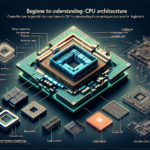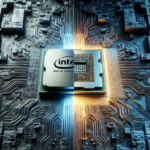Explaining the Use of CPUs in Autonomous Navigation Systems
Explaining the Use of CPUs in Autonomous Navigation Systems
Autonomous navigation systems are at the forefront of technological innovation, driving advancements in various fields such as automotive, aerospace, and robotics. Central to the functionality of these systems is the Central Processing Unit (CPU), which plays a critical role in processing data, making decisions, and executing commands. This article delves into the intricate use of CPUs in autonomous navigation systems, exploring their functions, importance, and the challenges they face.
Understanding Autonomous Navigation Systems
What Are Autonomous Navigation Systems?
Autonomous navigation systems are designed to enable vehicles or robots to navigate and operate without human intervention. These systems rely on a combination of sensors, algorithms, and computational power to perceive their environment, make decisions, and execute actions. They are used in various applications, including self-driving cars, drones, and robotic vacuum cleaners.
Key Components of Autonomous Navigation Systems
Autonomous navigation systems consist of several key components:
- Sensors: These include cameras, LiDAR, radar, GPS, and ultrasonic sensors that collect data about the environment.
- Processing Units: CPUs, GPUs, and specialized processors that analyze sensor data and make decisions.
- Algorithms: Software that interprets sensor data, plans routes, and controls the vehicle or robot.
- Actuators: Mechanisms that execute the decisions made by the processing units, such as motors and steering systems.
The Role of CPUs in Autonomous Navigation Systems
Data Processing
One of the primary functions of the CPU in autonomous navigation systems is data processing. The sensors continuously collect vast amounts of data, which the CPU must process in real-time. This includes:
- Image Processing: Analyzing data from cameras to detect objects, lane markings, and traffic signs.
- Signal Processing: Interpreting data from radar and LiDAR to create a 3D map of the environment.
- Sensor Fusion: Combining data from multiple sensors to create a comprehensive understanding of the surroundings.
Decision Making
After processing the sensor data, the CPU is responsible for making decisions based on the interpreted information. This involves:
- Path Planning: Determining the optimal route to reach a destination while avoiding obstacles.
- Behavior Planning: Deciding how the vehicle or robot should behave in different scenarios, such as stopping at a red light or yielding to pedestrians.
- Control Commands: Sending commands to actuators to execute the planned actions, such as steering, accelerating, or braking.
Real-Time Performance
Autonomous navigation systems require real-time performance to ensure safety and efficiency. The CPU must process data and make decisions within milliseconds to respond to dynamic environments. This necessitates high computational power and efficient algorithms to minimize latency.
Challenges Faced by CPUs in Autonomous Navigation Systems
Computational Demands
The computational demands of autonomous navigation systems are immense. Processing high-resolution images, interpreting complex sensor data, and making real-time decisions require significant processing power. CPUs must be capable of handling these tasks without compromising performance.
Power Consumption
High computational power often comes with increased power consumption. Autonomous vehicles and robots need to balance performance with energy efficiency to ensure long operational times. This is particularly critical for battery-powered systems like drones and electric vehicles.
Heat Dissipation
Intensive data processing generates heat, which can affect the performance and longevity of the CPU. Effective heat dissipation mechanisms, such as cooling systems and thermal management techniques, are essential to maintain optimal CPU performance.
Reliability and Safety
Autonomous navigation systems must operate reliably and safely in various conditions. The CPU must be robust enough to handle hardware failures, software bugs, and external interferences. Ensuring the reliability and safety of these systems is paramount to prevent accidents and ensure user trust.
Advancements in CPU Technology for Autonomous Navigation
Multi-Core and Parallel Processing
Modern CPUs are equipped with multiple cores that enable parallel processing. This allows autonomous navigation systems to handle multiple tasks simultaneously, improving efficiency and performance. Multi-core CPUs can process sensor data, make decisions, and execute commands concurrently, reducing latency and enhancing real-time performance.
Specialized Processors
In addition to general-purpose CPUs, specialized processors such as Graphics Processing Units (GPUs) and Field-Programmable Gate Arrays (FPGAs) are increasingly used in autonomous navigation systems. GPUs excel at parallel processing and are ideal for tasks like image processing and deep learning. FPGAs offer customizable hardware acceleration, enabling efficient execution of specific algorithms.
Edge Computing
Edge computing involves processing data closer to the source, reducing the need for data transmission to centralized servers. Autonomous navigation systems leverage edge computing to process sensor data locally, minimizing latency and improving real-time performance. CPUs in edge devices play a crucial role in enabling this decentralized approach.
Artificial Intelligence and Machine Learning
Artificial intelligence (AI) and machine learning (ML) algorithms are integral to autonomous navigation systems. CPUs with AI and ML capabilities can process large datasets, learn from patterns, and make intelligent decisions. These advancements enable autonomous systems to adapt to complex environments and improve their performance over time.
Applications of CPUs in Autonomous Navigation Systems
Self-Driving Cars
Self-driving cars are one of the most prominent applications of autonomous navigation systems. CPUs in self-driving cars process data from cameras, LiDAR, radar, and other sensors to navigate roads, avoid obstacles, and make driving decisions. They handle tasks such as lane detection, object recognition, and route planning to ensure safe and efficient driving.
Drones
Drones rely on autonomous navigation systems to fly without human intervention. CPUs in drones process data from GPS, cameras, and inertial measurement units (IMUs) to maintain stability, avoid obstacles, and follow predefined flight paths. They enable applications such as aerial photography, surveillance, and package delivery.
Robotics
Autonomous robots are used in various industries, including manufacturing, healthcare, and logistics. CPUs in robots process data from sensors to navigate environments, manipulate objects, and perform tasks. They enable robots to operate autonomously in dynamic and unstructured environments, improving efficiency and productivity.
FAQ
What is the role of the CPU in autonomous navigation systems?
The CPU in autonomous navigation systems is responsible for processing sensor data, making decisions, and executing commands. It handles tasks such as image processing, signal processing, path planning, behavior planning, and control commands to enable autonomous operation.
Why is real-time performance important in autonomous navigation systems?
Real-time performance is crucial in autonomous navigation systems to ensure safety and efficiency. The CPU must process data and make decisions within milliseconds to respond to dynamic environments and avoid accidents.
What are the challenges faced by CPUs in autonomous navigation systems?
CPUs in autonomous navigation systems face challenges such as high computational demands, power consumption, heat dissipation, and ensuring reliability and safety. These challenges require advanced CPU technologies and efficient algorithms to overcome.
How do multi-core CPUs benefit autonomous navigation systems?
Multi-core CPUs enable parallel processing, allowing autonomous navigation systems to handle multiple tasks simultaneously. This improves efficiency, reduces latency, and enhances real-time performance by processing sensor data, making decisions, and executing commands concurrently.
What is the significance of edge computing in autonomous navigation systems?
Edge computing involves processing data closer to the source, reducing the need for data transmission to centralized servers. In autonomous navigation systems, edge computing minimizes latency and improves real-time performance by processing sensor data locally. CPUs in edge devices play a crucial role in enabling this decentralized approach.
Conclusion
The use of CPUs in autonomous navigation systems is pivotal to their functionality and performance. CPUs handle the complex tasks of data processing, decision making, and real-time execution, enabling vehicles and robots to operate autonomously. Despite the challenges they face, advancements in CPU technology, such as multi-core processing, specialized processors, edge computing, and AI capabilities, continue to drive the evolution of autonomous navigation systems. As these technologies advance, we can expect even more sophisticated and reliable autonomous systems that transform various industries and improve our daily lives.



